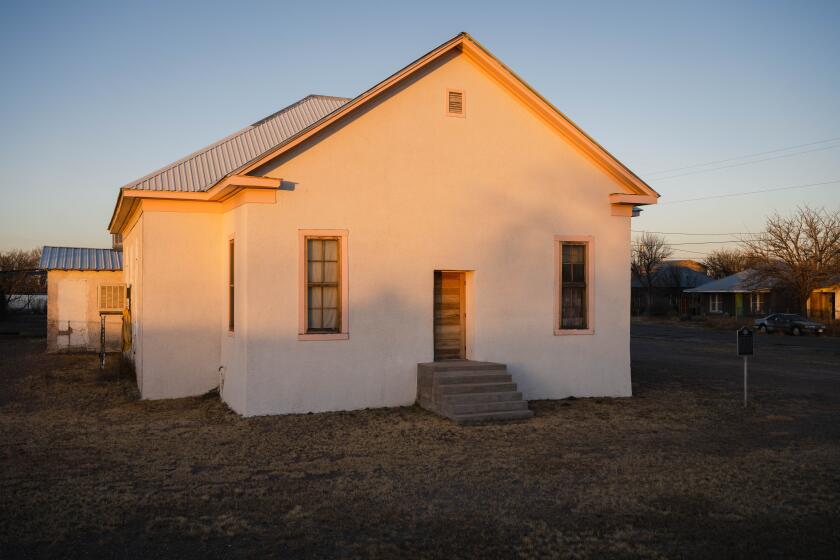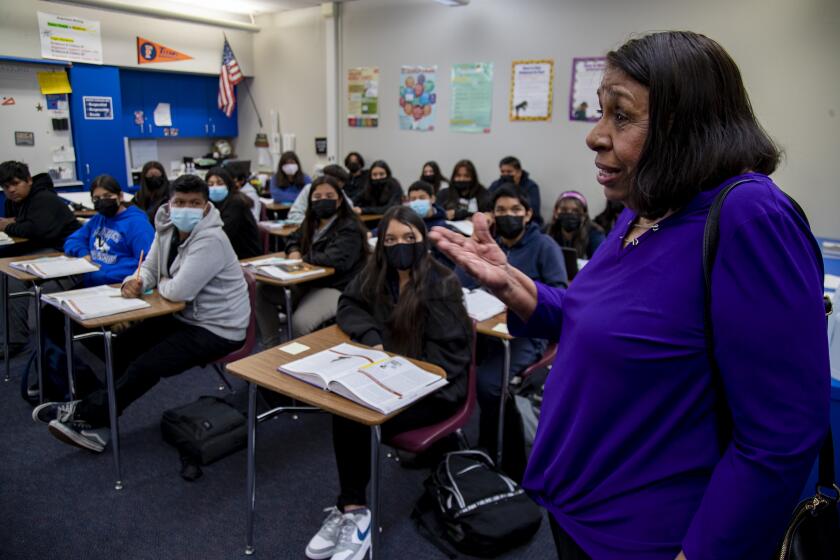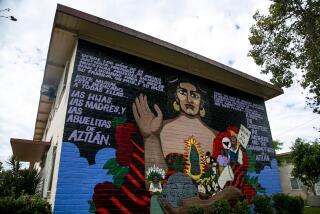Sent to the ‘Mexican school’ 75 years ago, Sylvia Mendez’s fight for equality continues
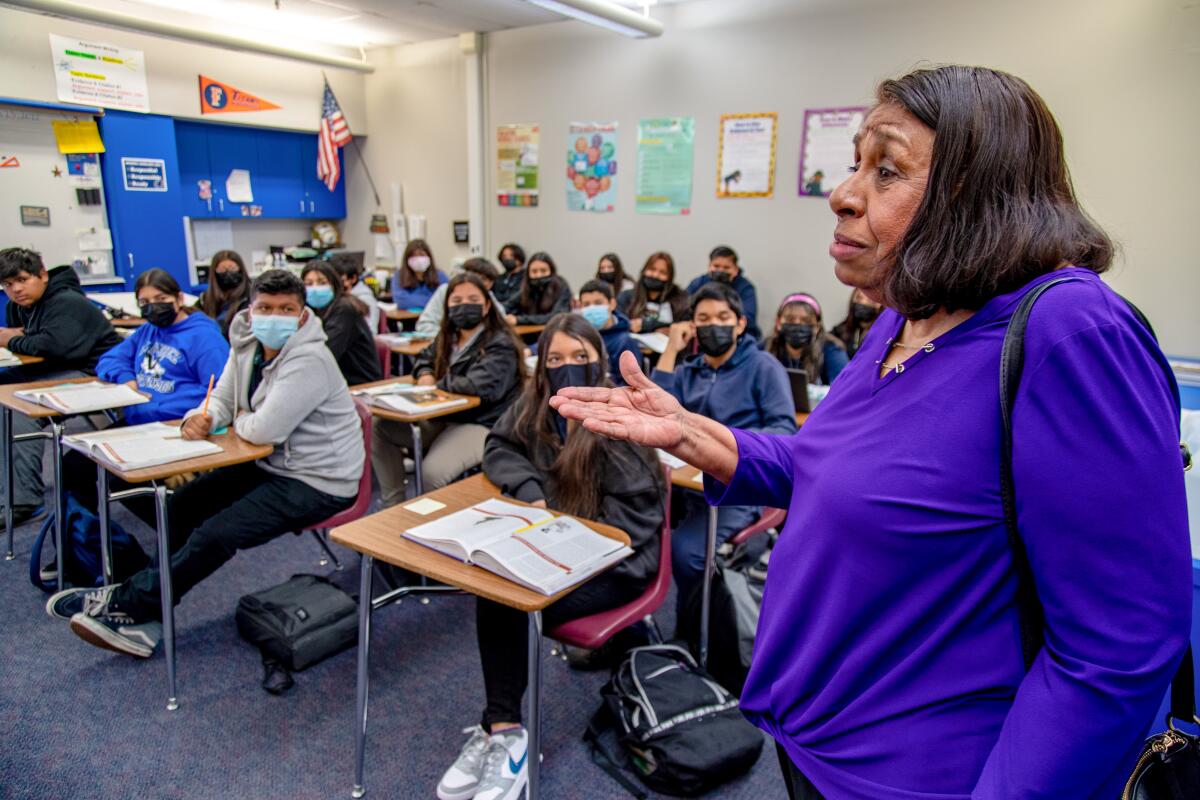
- Share via
On a spring morning, Sylvia Mendez walked into an eighth-grade history classroom in Santa Ana and began a talk she’d given hundreds of times before. At 85 years old, she held steady with a cane.
Her voice was soft but her message strong.
“Never get distracted,” she told the students in front of her. “You have to fight for what you want.”
Seventy-five years ago this month, Mendez’s parents and four other Orange County families won the landmark class-action court case Mendez, et al. vs. Westminster School District of Orange County, allowing her to leave the neglected “Mexican school” she was forced to attend and enroll in a whites-only school with a beautiful playground she still remembers with a smile.
The case helped lead to the desegregation of California schools and influenced the legal arguments that were used in Brown vs. Board of Education seven years later, when the U.S. Supreme Court declared that separate schools based on race were unconstitutional.
The Brown decision is well known. Less well known is how segregationist policies pushed Latino students into substandard schools throughout the Southwest.
A once-segregated Mexican American school in Texas may become a historic site.
That is the story that, for decades, Mendez has dedicated herself to telling — to ensure that the story of her parents’ fight is not forgotten. She’s traveled across the country to speak with students, including frequent stops here, at Mendez Fundamental Intermediate School. It was named for her family.
She is also keenly aware that the fight for equal education is not over. Schools are still segregated, though for different reasons today, and Latino students are still being left behind. The inequities have only been exacerbated by the COVID-19 pandemic and school closures.
She keeps telling her story in hopes of persuading young people to fight for their own education.
Some 75 years ago, Mendez, et al. vs. Westminster ended the practice of segregated Mexican schools in California. But today, Latino students are as segregated as ever.
“I’m so proud of you,” she repeated again and again to the students that spring morning. Then, gently, she reminded them: “Sometimes it’s a struggle to get what you want. But you just don’t give up.”
She repeats the story of Mendez, et al. vs. Westminster for another reason as well — to fulfill a promise to her mother.
Decades later, the details remain vivid.
She was 8 years old when her family moved from Santa Ana to Westminster during World War II. Her father had agreed to lease a farm belonging to Seima and Masako Munemitsu, a Japanese American family who had been forced into an internment camp.
Mendez’s aunt tried to enroll her, her two brothers and cousins in the neighborhood school, 17th Street School, the one with a manicured lawn, palm trees and the playground that Mendez still remembers.
An official told her the cousins would be allowed to enroll. They were fair skinned and had a French last name. But Mendez and her younger brothers, Gonzalo and Geronimo, were turned away and sent to Hoover, a “Mexican school.”
She recalls that school clearly: two shacks surrounded by dirt and an electrified barbed wire fence meant to keep the cows in a neighboring field from wandering away.
Her mother, Felicitas, who was born in Puerto Rico, and her father, Gonzalo, who was of Mexican decent, decided to fight.
They joined four other families from across the county — the Guzman family of Santa Ana, the Palominos of Garden Grove, the Estradas of Westminster and the Ramirez family of El Modena. Together, their class-action lawsuit challenged segregation in the name of thousands of children.
With her father focused on the case, Mendez said, it fell to her mother to take care of the farm and her family.
At trial, school officials tried to argue that the separation of students was based on language ability. But those arguments floundered, with one superintendent arguing on the stand that Mexican children were inferior in “their economic outlook, in their clothing, [and] their ability to take part in the activities in school.”
In his decision, the federal court judge wrote that equal protection “is not provided by furnishing in separate schools the same technical facilities, textbooks and courses of instruction to children of Mexican ancestry that are available to the other public school children regardless of their ancestry. A paramount requisite in the American system of public education is social equality.”
Mendez recalls sitting in the courtroom as a child, not understanding the legal language.

So many years later, as she stood in the eighth-grade history classroom at Mendez, a boy raised his hand and asked: “How did it feel when you found out that your parents were in a fight for many, many children to go to school?”
“I didn’t even know they were fighting for many children,” she said. “I thought they were just fighting for me to get into a beautiful school.”
After the plaintiffs won the case, Mendez was allowed to attend previously all-white schools. There, some children treated her cruelly, telling her that she did not belong. Decades later, the memory of one boy who spat “Mexican” at her as though it was a slur, still stings.
But there were others who invited her to their homes and parties.
Attending those schools gave her the type of education she could not have gotten at the Mexican school. It also led her to lose the ability to fluently speak Spanish, a loss she still mourns.
After graduation, she studied to become a nurse and had been working for more than 30 years when she retired to care for her dying mother.
In her final months, Felicitas Mendez would frequently lament that the case she and her husband had sacrificed so much to win was unknown.
“We’d be there at the house and she’d say, ‘Ay, nadie sabe de este caso. Nosotros peleamos y nadie ha dicho nada.’
“No one knows about this case. We fought and no one speaks about it.”
No one knows about this case. We fought and no one speaks about it.
— Felicitas Mendez to her daughter, Sylvia Mendez.
Over and over before her death, Felicitas Mendez told her daughter, “Sylvia, someone has to tell the story.”
After Felicitas Mendez died in 1998, Mendez, who now lives in Fullerton, began traveling the country — to elementary schools, high schools, college campuses — to do just that.
Because of her efforts and those of the families of other plaintiffs in the case, the legal fight is more widely known.
Schools have been named for the Mendez family in California, Oklahoma and Texas. There is a Lorenzo A. Ramirez Library at Santiago Canyon College in Orange.
In 2007, the U.S. Postal Service issued a commemorative stamp honoring the case. And in 2011, Mendez was honored for her work by President Obama with the Presidential Medal of Freedom, the nation’s highest civilian honor.
Still, quite often the students she talks to have never heard of Mendez, et al. vs. Westminster.
If they know about the desegregation of schools, it’s typically in the context of Brown vs. Board of Education. Sometimes, they have learned about segregation only as something that happened in a faraway place, mostly to Black students, in a past that is removed from their day to day.
“I was surprised at how it was very recent,” said eighth-grader Desiree Arevalo-Gil. “I didn’t know that schools were just segregated less than a hundred years ago. It wasn’t that long ago.”
Then Mendez, with her vivid memories, walks into the room and tells them about the playground, the electrified fence and the little boy who said to her: “You’re a Mexican. Who said you could come to this school?” Then he told her to leave.
“She talks about her story in a really heartfelt manner and the students really connect to it,” said Linn Lee, a curriculum specialist for Santa Ana Unified School District, who teaches a summer class at which Mendez is often a guest speaker.
“They also connect to their own experiences today,” she added. “How they still sometimes don’t feel completely equal.”
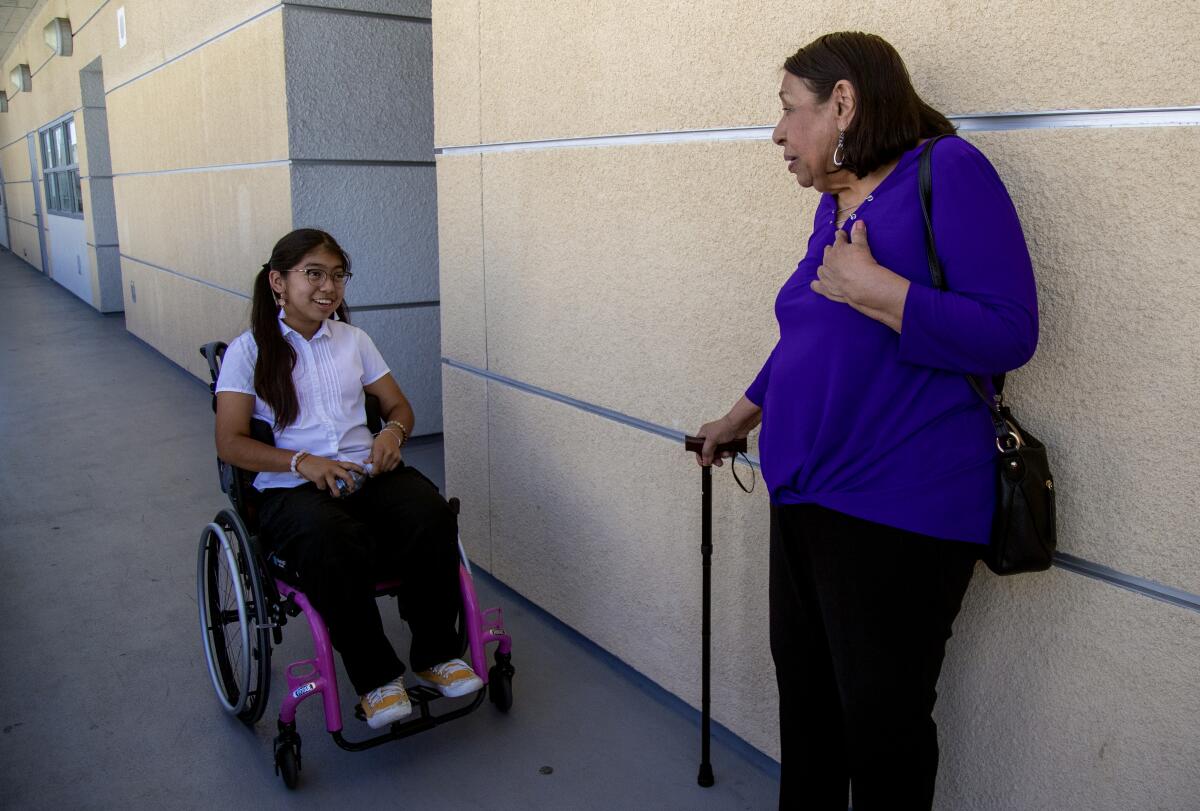
As Mendez traveled the country to tell her story, she began to see firsthand how the segregation her parents fought not only persisted, but it had become deeply entrenched in schools.
“I started going from city to city and discovered that some of them were 100% Latino or 100% African American,” she said. “I thought, ‘Oh my God.’”
Even Mendez Fundamental Intermediate is 99% Latino. Mendez is keenly aware of the irony.
“Two schools named after my family, the one in Los Angeles and Santa Ana, they both are almost 100% Latino. What does that tell you?” she asked.
The reasons behind segregation are different than they were in 1947. Latinos and other students of color now make up a large majority of students in California.
Communities throughout the state are highly segregated, reflecting a long history of discriminatory housing policies and the aversion of many communities to allow low-income housing. District boundaries align with those communities.
Santa Ana Unified, for example, is 96% Latino and 85% of its students come from low-income families. About 60% of graduates last year met the requirements to attend a public university in California.
Fifteen miles away in Laguna Beach Unified, 12% of students are Latino, 11% are from low-income families and nearly 80% of graduates met the requirements to attend a public university in California.
In the years since the Mendez case, court decisions and political ones have made it incredibly difficult to challenge those realities the way Mendez, et al. vs. Westminster challenged segregation 75 years ago.
From Mendez’s perspective, that’s why it’s so urgent that she keep talking to students, keep trying to inspire them, keep telling them: “I’m so proud of you.”
If they can just persevere and get an education, they can earn enough to move into communities where their children will have better opportunities.
“They can’t stop you from living in Huntington Beach. They can’t stop you from living in Tustin or anywhere,” she said. “If you have enough money you can buy a house wherever you want. In Bel-Air. In Los Angeles. Buy a house here in Laguna Beach. You can buy anywhere. And then you’ll go to schools in that area.”
Before wrapping up her visit at Mendez Fundamental Intermediate, Mendez explained to the students how she started visiting classrooms to fulfill a promise to her mother not to let the case be forgotten.
“I think I have honored my mother,” she told them.
She walked outside and marveled at the campus that carries her family name. “We’re so lucky to have this beautiful school,” she said.
Mendez Fundamental Intermediate has a large field and modern classrooms. Then there’s something you likely won’t find at other schools: walls lined with aging newspaper clips and photos depicting her parents’ fight.
More to Read
Sign up for Essential California
The most important California stories and recommendations in your inbox every morning.
You may occasionally receive promotional content from the Los Angeles Times.
